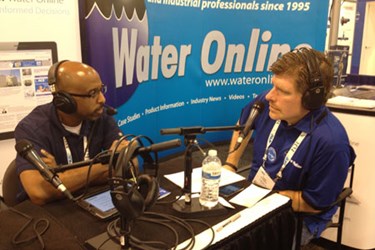Advanced Metering Analytics Brings Higher Visibility To Water

Morrice Blackwell, Marketing Manager at Badger Meter, explains how Advanced Metering Analytics enhances understanding of usage data for both water customers and utilities.
The following is an excerpt from a Q&A with Water Online Radio. Click on the Radio Player above to hear the full interview.
Water Online Radio: AMA. AMI. AMR. Talk a little bit about what those things are; why they are important; and how they fit into a solution for customers.
Morrice: Well, AMR has been out for years. We've had the first AMR systems, automatic meter reading systems, around since probably the late ‘80s. The first AMI system, fixed network system, came out in water around 1996.
Since that time, there have been many, many manufacturers that have come out with great fixed network water products. The issue in the past is that most manufacturers have simply presented hourly interval data to customers.
That's a great thing for customers to have, that hourly interval data. But the issue is that the customers don't understand what they can do with it. That's where AMA comes in. AMA is advanced metering analytics, and it takes advantage of that hourly interval information.
We like to say it like this – it brings visibility to water. It takes all of the exception conditions that the customer cares about, the things that they're concerned about in their water utility, and it gives them a way to understand and see those things, by providing proactive notifications when those issues do arise.
Water Online Radio: I understand that you have two new leak center analytics packages? Tell me more about those and how they work with existing technology.
Morrice: We have two new packages called Read Center Analytics Plus, which is our first package, and Read Center Analytics Pro. Read Center Analytics Plus is designed for our mobile customers. Read Center Analytics Plus is designed for our fixed network customers.
The advantage that these products have is they bring the AMA solution right to the forefront of the customer's day to day operations.
Let's say I'm concerned about some of my larger users in my system. Let's say I've got a series of hotels, and the series of hotels may make up, let's say, 80 percent of my revenue if I were a utility.
Well, many utilities will go out of their way to make sure these meters are up and running every day, making sure that they're performing as they should. But that takes a lot of man hours to do that.
They may send someone out to visually inspect these meters every day. Think about having the power of hourly interval data right at your fingertips, right at your desktop every morning when you come in.
You're able to set up analytics criteria that say, “Hey, if this meter starts to run slow, or this meter were to stop, send a notification to someone. Send them an SMS text, send them an email or send them a notification to their dashboard.” That's where the AMA comes in.
Water Online Radio: You've talked a lot about hourly interval data and how the data's collected and the infrastructure to collect it. What information, specifically, are we talking about?
Morrice: You're talking about the hourly interval data, but you're also talking about exception conditions, like your leaks, your tampers, your reverse flow conditions. Those are the types of things that utilities care about.
Water Online Radio: Well, how does a utility really use all this information? Ultimately, it's got to be some combination of customer service and reducing cost, but talk a little bit deeper about those two things.
Morrice: That's a great segue, Todd. Customer service is one of the first ways that a utility can benefit from an AMA system. One of the problems that every utility has every day is billing disputes, right? Customers come in every day and they say, “Hey, I've got this high water bill. There's no way I could have used this water,” but what happens?
Most of the time, the customer has, but now that you have the hourly interval data, you have a proof source to present to the customer to show them exactly how they use their water. Many times, that proof source allows the customers to understand maybe where they have an issue.
Maybe they have a continual leak. Maybe it's a leaky toilet or a leaky faucet that's causing this high water bill. Customer service is one of the best ways to approach it. The other area within a utility where AMA comes into play is conservation.
This is probably the greenest aspect of AMA. Things like conservation. Every utility's looking to find out where they have leaks in their system. AMA allows you to do that.
We will take one of our AMI products and hook it up to a permalog leak detector that can monitor the distribution systems. When there's a leak in the distribution system, it can then, in turn, send that information back to the utility, letting them know where that leak can be found.
Water Online Radio: What's on the horizon, Morrice?
Morrice: You know, where I think our industry is going as a whole, when it comes to advanced metering analytics and AMR in general, is customer engagement.
How can we bring some of that information now to the end consumer? I see things like consumer portals and smart phone applications being able to bring some of that data right back to the end consumer, to make them a better user of that water…
Click on the Radio Player above to hear the full interview.
